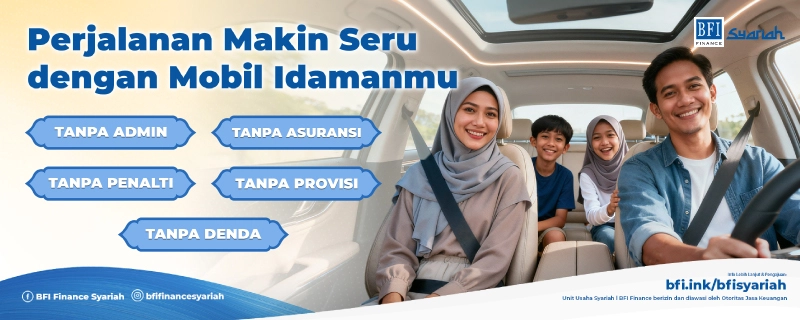Eid al-Fitr has passed, and it’s time to return to the “real” world. Many people realize that their spending during the last few days—especially throughout Ramadan and the lead-up to Eid—significantly drained their finances and savings.
The period after Eid often becomes a financial test for many. Some even have to postpone fulfilling certain wishlists until their financial situation stabilizes again, especially given the current economic uncertainties. But don’t worry—everything can be managed with discipline and the right strategy.
After loosening the purse strings to meet various Eid needs, now’s the time to reorganize your finances to stay on track—one of which is through saving. Here are some tips to help you start saving after Eid so your wallet stays healthy and your finances remain in control:
1. Create a Financial Budget
The first step in managing your finances after Eid is to create a detailed financial budget. Record all income and expenses each month. With a clear budget, you can identify which expenses are necessary and which can be delayed or reduced.
2. Don’t Forget the Emergency Fund
Emergency funds are essential in financial planning—especially if they were used during the Eid period. Start replenishing them little by little. This fund acts as a “safety net” during unexpected situations like illness, job loss, or urgent needs.
3. Reduce Impulsive and Consumptive Spending
After Eid, it’s time to control your spending habits. The temptation to shop or splurge is definitely there—especially if you still have leftover Eid bonuses. But hold back from buying things you only want. Focus on fulfilling your needs first.
4. Try the 50/30/20 Rule

Image Source: Freepik
This method is perfect for those learning to manage their finances in a structured way. The 50/30/20 rule divides income into three main categories:
4.1 50% for Essentials
Allocate half of your income for essential and primary needs such as:
- Daily food expenses
- Utility bills (electricity & water)
- Mortgage or vehicle installments
- Transportation
- Children's education
- Household necessities
Make sure this category covers only essential spending—not wants.
4.2 30% for Wants and Lifestyle
This portion can be used for lifestyle and leisure, such as:
- Dining out
- Holidays
- Fashion shopping
- Streaming platforms
- Hobbies & self-rewards
Still, be wise—not over budget!
4.3 20% for Savings and Investments
Set aside at least 20% of your income for savings or investments. This is your preparation for the future, including:
- Emergency fund
- Children's education savings
- Investments (mutual funds, stocks, or gold)
- Retirement fund planning
5. Save in Your Own Way!
Saving doesn’t have to be the same for everyone. Choose the method that best suits your financial situation.
5.1 Save with Piggy Banks or Envelopes
This classic method is still popular. Prepare a special piggy bank at home, or separate cash into labeled envelopes—such as for daily savings, vacation funds, or emergency funds.
5.2 Increase Savings Periodically
Challenge yourself to raise your saving amount each month. For example: Rp100,000 in the first month, Rp150,000 in the next, and so on. This helps build discipline and grow your savings.
5.3 Save Through Mutual Funds or Other Investments
If you want more optimal results, consider saving through investment instruments such as mutual funds, digital gold, or deposits. These are safe and offer returns aligned with your risk profile.
5.4 Use Bank Auto-Debit Features
Take advantage of auto-debit features from banks or financial apps. Set it up so that a portion of your salary is automatically transferred to your savings. This is an effective way to save without forgetting.
5.5 Save Loose Change or Spare Cash
Don’t underestimate coins or small change. Collect them in a special jar—and after a year, they can become extra funds for holidays or emergencies.
6. Build Sustainable Saving Habits
Saving isn’t just about the amount—it’s about consistency and habit. After Eid, it’s the perfect time to develop healthy and sustainable saving habits. How?
6.1 Pay Off Debt First
Before you start saving, prioritize paying off debts—especially high-interest ones like credit cards or online loans. Being debt-free means a calmer mind.
6.2 Separate Savings and Daily Accounts
To avoid “accidentally” spending savings, keep your savings account separate from your daily account. Ideally, use a savings account without an ATM card to avoid easy access.
6.3 Save First, Spend Later
The right mindset for saving is: Save first, spend later. Right after receiving your salary or income, allocate a portion immediately to savings—don’t wait for what’s left at the end of the month.
6.4 Find Extra Income
Besides managing expenses, another way to reach your financial goals faster is by earning extra income. In this digital era, many opportunities are available—freelancing, offering your services, online selling, or small-scale investments.
6.5 Saving Isn’t Easy, But It’s Possible
Saving money is not always easy, especially with rising living costs. Sometimes, temptations to dip into your savings arise, or your income might feel insufficient. But trust the process—saving is about habits and consistency. You don’t need to save a large amount right away; what matters is being regular. Enjoy the process, and reward yourself for every saving milestone, no matter how small.
Saving after Eid isn’t always easy—especially after the thrill of shopping, giving gifts, and travel expenses. But take heart: your financial situation can recover with proper management.
If you’re planning something big—like starting a business, expanding one, or need extra funds for other important needs—don’t let those plans be delayed.
BFI Finance is ready to help make your plans come true. Get financing using your motorcycle BPKB, car BPKB, or property certificates, with an easy process and flexible terms.
#SelaluAdaJalan with BFI Finance.
BFI Finance is licensed and supervised by the Financial Services Authority (OJK).







